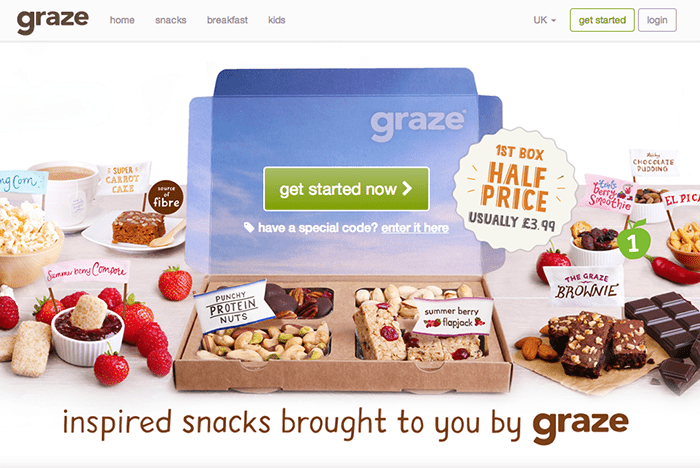Why Monthly Subscription Boxes Are Booming

It’s possible that you may even already subscribe to a few of these services. For instance, a few popular subscription box services that you’d see advertised on TV and Facebook include Bark Box, Blue Apron, Trunk Club, Monthly CPAP Club and Dollar Shave Club, among countless others.
But just how popular have these startups become, and is there really room for growth in this industry?
Dollar Shave Club Sets The Standard
To put it into better perspective, Unilver recently tendered $1 billion to acquire Dollar Shave Club, denoting one of the largest sums ever tendered for a tech startup that’s only been around for four years. This massive, and unprecedented, transaction also helps us better assign an actual face value to the subscription box services industry.
Back in 2012, during the first year of business for Dollar Shave Club, the company posted a viral YouTube video (shown above) that resulted in 12,000 orders in just 24 hours, and that resulted in over $240 million in revenue. In just a few years, the startup had garnered 8% of the market share of a multibillion men’s shaving industry that was previously untouchable.
Was Dollar Shave Club really doing anything different? Nope. They were selling cheap, mass produced razorblades to a price-weary target market, in hopes that convenience, branding, catchy commercials, packaging and front-door delivery would make the difference. The venture also proved another thing: These services can generate billions of dollars inside of multiple niches, thus leading to the spawning of an industry within an industry.
Popularity Has Led To Creation Services
In the years that followed the rampant success of a generic razorblade reseller, countless other entrepreneurs got on board the ecommerce bandwagon. They began selling everything and anything in a subscription box that could be sent inexpensively via USPS Priority Mail within just three days. From subscription boxes for men to subscription boxes for women, subscription boxes for teens and even subscription boxes for kids. Of course, with such high demand, you know that another industry had to get on board the cash flow express: The shopping cart and frontend IT industry.
In entered newer shopping cart providers that made it even easier to get your subscription box service up and running. Services like Subbly (featured above) now allow you to create a specialty online subscription box store with plenty of useful tools – such as web hosting, shopping cart functions and design that you’ll ever need – for a reasonable monthly payment.
Pros & Cons
Over just the past two years, we’ve seen subscription box services of all kind seemingly pop up from out of nowhere. Need gourmet, gluten-free, sugar-free, farm-to-table, ready-to-eat meals delivered daily to your front door? Then you need look no further than Freshology. Want premium cosmetics delivered each month to your door? Then Birchbox has you covered.
Everything from shoes to candy/snacks such as Graze (featured above) offers, to accessories, personalized outfits and what-have-you are now readily available from these services. But with this fad, and amid all the hyperbole surrounding it, one thing was left overlooked for many of these startups: The logistics that are involved, and just how nightmarish daily operations can quickly become once your business takes off; if you are not prepared, that is.
Logistics and getting packages fulfilled when they are typically hand-packed and different each month has caused some trouble for startups in this category, according to the Wall Street Journal. In their publication, the news outlet cites an example of a beauty box supplier called Glossybox that features tied ribbons inside of the boxes. Each ribbon is tied by hand, accounting for a massive of amount of labor.
“Doing the bow 500,000 times is not easy. Some people just cannot do this,” said Britta Fleck, president of Glossybox U.S.A., in an interview with WSJ. “It sounds ridiculous, but if the box is open and it’s not a nice bow, the experience is already lower.”
Most subscription box services have to resort to manual fulfillment because the boxes are so customized, and the monthly content varies so greatly, that it’d be nearly impossible to use robotic fulfillment methods. This means that many turn to fulfillment houses to get their packages sent, which cuts deeply into their baseline profit margin.
The experts at Econsultancy dug deeper into the worries that ecommerce monthly subscription services providers would have to fester when it comes to risk versus reward.
- Discount entry points can really cut into profit margins, and can leave a retailer breaking even or losing money on the first sale.
- Spend versus return can sometimes even out, especially when costly marketing campaigns are being used.
- Cross-channel selling can deplete profit margins, and can make it hard to turn around cost in the long term if acquisition is too heavy.
- Stock on-hand can become an issue when supplies are short, resulting in an exodus of subscribers.
- Risk of cancellation, returns and long term viability of customers as well as chargebacks and fraud always need to be considered in the long term.
Things to Consider
In spite of the risk, where entrepreneurs see a cash cow, they flock like sheep to the opportunity. Not to say that you can’t make a good amount of money in with a subscription box store, just to say that the market is quickly becoming diluted, and that you shouldn’t be overzealous or delusional in your approach. Of course, many of these businesses are taking off quite quickly, and are turning handsome profits during the first two years of operations; during a pivotal survival time frame where the majority of new businesses fail.
The services that do take off are using the right model, HubSpot infers. They explain how the successful subscription model works in a nutshell. It involves knowing your LTV, or the lifetime value of your customer, versus existing subscriptions, which is the first place that you’d want to start.
“For example, if your subscription is $100/month (and it’s all pure profit, in a real scenario you’d factor out costs of goods and services and retention etc.) and 1% of your customers cancel each month, your customer life time value (CLTV or just LTV) is $100/1% (100/0.01) which is $10,000.”
Other advice that can be offered includes:
- Offer minimal choices: Limit the choices that consumers have with your subscription boxes so that you can prevent a logistics nightmare, and can more easily maintain stock while easing fulfillment.
- Feature simple shipping plans: Make your shipping plans simple and easy to understand. Most online subscription boxes do not weigh that much and qualify for expedited USPS Priority Mail shipping, which saves you and your subscribers a lot of money.
- Do the work of buyer: The greatest value that you have to offer to the subscriber is by doing a lot of tedious work for them that they would otherwise have to do. With convenience and consistency, you can win over subscribers in the long term.
Why They’re Taking Off
The immense popularity of ecommerce subscription boxes is no mystery. Take for example the FiveFourClub, a men’s personalized shopping subscription service that’s offered online. Their Unique Value Proposition (UVP) includes access to capsule collections from premier designers, additional access to a special online store, a men’s style guide, free returns, free shipping, free exchanges, and the ability to skip a month or cancel service at any time, with plans that start as low as $60 per month.
The innovation of premier services like these helps us better understand just how multifarious the internet’s offerings can be. As they continue to gain in popularity, they are adding billions of dollars in value to an already rapidly expanding ecommerce industry; one that’s only going to continue to grow as time passes.
In parting, we leave you with this exceptional infographic about ecommerce subscription boxes that was created by Shor Packaging. It helps explain the rise and boom of this niche market industry.

What You Should Do Now
Here are 3 ways ReadyShipper X can help you instantly cut shipping costs, keep delivery promises, and scale fulfillment without adding headcount:
Schedule a Demo – See how ReadyShipper X combines on-premise speed with cloud flexibility to ship your orders faster and cheaper, delivering the speed customers expect at costs that protect your margins.
Start Your Free Trial of ReadyShipper X (No CC Required) – Get up and running in minutes with instant access to multi-carrier rate shopping, smart automation, and enterprise features.
Try ReadyCloud at No Cost – Why manage shipping and returns separately? Get ReadyShipper X, ReadyReturns, and more in one unified platform for faster fulfillment, fewer headaches, and happier customers.
Share On:










